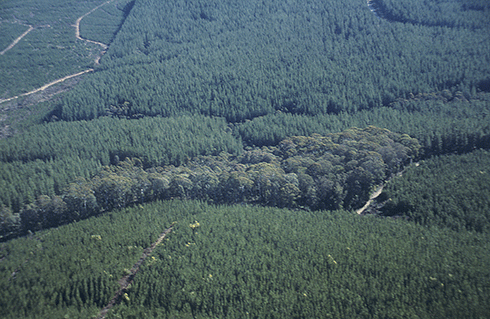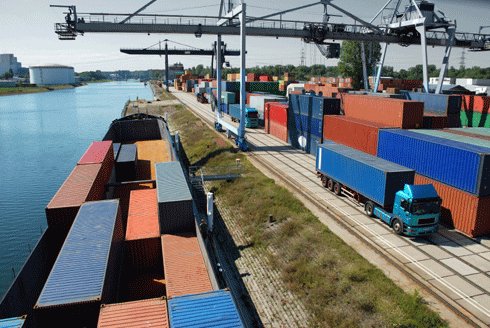
|
Published: 8 September 2014
Pine fiction: can plantations really re-connect bird species?
Forest plantations are everywhere. You’ll find them in almost every vegetated country in the world. They cover a surprisingly large portion of our planet – some 260 million hectares, corresponding to 7 per cent of global forest cover.

|
|
A patch of remnant woodland in a sea of pines: new research suggests the pine trees do not facilitate the movement of birds from patch to patch. Credit: A Mortelliti
|
They are expanding at an impressive rate: according to the Food and Agriculture Organization, every year an area roughly equivalent to the size of Switzerland (around 5 million hectares) is converted to planted forest. It is estimated that by 2020, planted forest will cover 300 million hectares, which is equivalent to half the size of the Amazonian rainforest.
Why are we converting such a large area of the planet to this ‘artificial biome’? There are two main reasons: an increasing demand for wood used for timber and paper, and the need to sequester carbon to mitigate global warming.
Despite the considerable amount of research that has been conducted on the impact of plantations on biodiversity, there is little agreement on whether plantations are a ‘biological desert’, or a ‘lesser evil’ compared to agricultural land. As a consequence, landscape managers have a confusing body of empirical evidence to support their decision-making whether or not to convert agricultural land to plantations.
Considering the extremely large areas of the planet that are converted to planted forest each year and the parlous state of our biodiversity, the question of whether pine plantations improve species connectivity is far from academic.
We carried out a study that sought to bring some clarity on the topic. Our analyses were based on data from the ‘Nanangroe experiment’, one of the largest landscape transformation experiments ever established, and managed by Professor David Lindenmayer’s research group at the ANU since 1998.
The Nanangroe experiment has involved monitoring changes to fauna inhabiting woodland remnants set in a mixed open woodland-grazing landscape, over a period in which some of that landscape has been converted to a massive pine plantation.
Nanangroe is 10–20 km southeast of the town of Jugiong in south-eastern NSW. Over the past 170 years, approximately 85 per cent of the original temperate Eucalyptus open woodland in the area has been cleared for livestock grazing. Nanangroe Station is a large property where a sizeable radiata pine plantation was established in the late ‘90s.
The setup of our recent experiment is simple: bird populations found inhabiting 50 ‘treatment’ patches of eucalypt woodland (i.e. patches surrounded by pine plantations) were compared to populations found in 50 ‘control’ patches of Eucalyptus (i.e. patches surrounded by grazed fields).
The focus of our study was the connectivity between different bird populations – that is, on the flow of migrating individuals between the patches of woodland remnants. Population connectivity is a key ecological parameter; however, estimating it directly is an extremely difficult task, which becomes prohibitive when many species are being monitored.
A key feature of the experiment is that habitat within the Eucalyptus patches remained unchanged in control and treatment sites. It was thus possible to isolate the impact of pine plantation with limited ‘background noise’ from other confounding factors.
Our results, published in the Journal of Applied Ecology, were surprising – especially if, like many people, you believe that trees in the landscape make it easier for birds to get around. What we found is that the introduction of pine plantations did not increase connectivity for any of the 52 bird species examined.
In fact, the pine plantations acted as a barrier for four of the species, whereas for the remaining 48 species, the effect of pine plantations was neutral – it did not significantly affect the connectivity between populations.
The implications of our findings for landscape management are clear. The conversion of agricultural areas to plantation forestry is unlikely to promote substantial movement of individuals between fragmented populations of a species.
Therefore, we strongly suggest that the expansion of pine plantations should not be promoted in the belief that it may provide increased connectivity for birds compared with existing grazing-open woodland habitat.
See the movie: author Alessio Mortelliti made this movie with Christina Thwaites to communicate the findings the research.
Credit: A. Mortelliti, C. Thwaites
Alessio Mortelliti is a field ecologist working on the impact of land use change on vertebrates. He gained his PhD at the University of Rome and is currently a Research Fellow at the Australian National University. His main interest is in trying to understand mechanisms triggering extinction in fragmented landscapes. This article first appeared in Decision Point – a free monthly online publication from the Environmental Decisions Group (EDG) network.
|
Pinus radiata D. Don, the best-known expatriate of the North American conifers, is the world’s most extensively planted exotic softwood. The species is still referred to as Monterey pine in the US and some other English-speaking countries. |
There are over four million ha of radiata pine planted worldwide, with the largest plantations in Chile and New Zealand (about 1.5 million ha each) and Australia (0.77 million ha). Between them, these three Southern Hemisphere countries account for over 90 per cent of the world’s radiata pine plantations. |
The planting of radiata pine as an exotic has given the species a new lease of life. Before that, it was a relict species in its native habitat; it was able to survive against more long-lived species such as Douglas fir only because of its resilience to fire. Today, the area of radiata pine with a natural understorey in California is about 5300 ha; another 4500 ha with varying canopy cover exists in developed areas. |
The first commercial plantation of radiata pine in Australia was in 1876 at Bundaleer, South Australia. The first plantations in NSW and Victoria were established in 1878 and 1880, with the first commercial radiata pine plantation in NSW being planted in 1912. |
The area of radiata pine plantations in NSW, Victoria, South Australia, Tasmania and Western Australia expanded rapidly between the 1960s and the 1990s, often through the initiative of state governments. Almost half the total area of the country’s radiata pine plantations is in the Murray Basin and Green Triangle wood-supply regions of Victoria and South Australia. In recent years, the state governments of Victoria and Tasmania have sold their plantations and large parts of their estates are now owned or managed by private companies. |
Edited extract from FAO Forestry Paper 170 (2013) ‘Sustainable management of Pinus radiata plantations’. |



